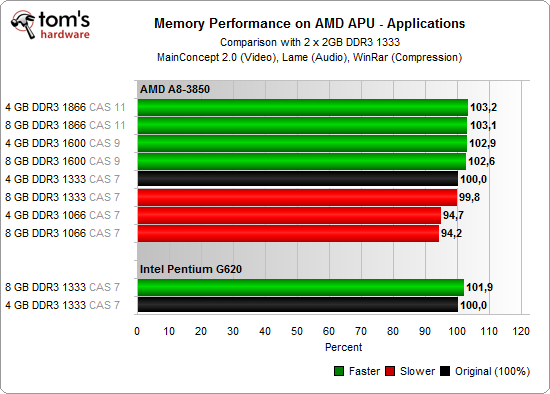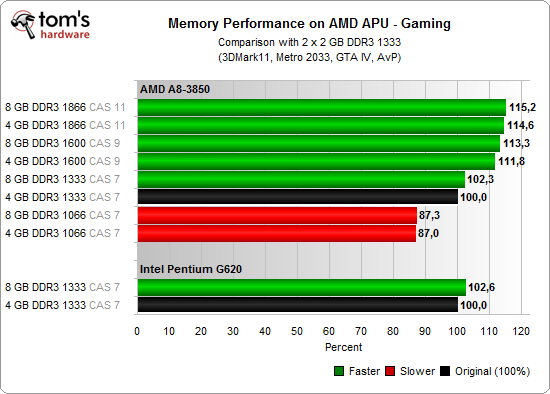Build It: Picking Parts For Your Kid's Entry-Level Gaming PC
Does your child always want to use your PC? Is it time to build him his own? If you don't trust the tier-one vendors to sell you a well-balanced machine, you'll be happy to know that you can piece together your own entry-level box for less than $450.
Memory Capacity And Data Rate
Memory Speed
Intel's entry-level chips are limited to DDR3-1066 memory speeds. As long as you're looking at kits rated for less than 1.65 V, we recommend arming the Pentium and Celeron configurations with the cheapest modules that you trust.
AMD’s APUs are compatible with kits running at up to DDR3-1866. The reason they accommodate more aggressive data rates is to provide the on-die graphics engine with plenty of memory bandwidth. Consequently, it's more important to choose the right speed, and potentially spend a little more money on higher-end modules.
| Header Cell - Column 0 | 4 GB (2 x 2 GB) | 8 GB (2 x 4 GB) |
|---|---|---|
| DDR3-1066 | $25 | $42 |
| DDR3-1333 | $22 | $39 |
| DDR3-1600 | $27 | $41 |
| DDR3-1866 | $34 | $55 |
Memory Capacity
The next important question to answer is how much memory should you buy? Motherboards in our price range typically feature a pair of slots, leaving us to choose between 4 GB (2 x 2 GB) or 8 GB (2 x 4 GB). We decided to use modules with the highest latencies, since they're cheaper. Seeking out low-latency DDR3-1866 kits, in particular, can become an expensive task.
Our benchmarks demonstrate large jumps in performance from 1066 to 1333 MT/s, as well as 1333 and 1600 MT/s on AMD’s APUs. The difference between 1600 and 1866 MT/s is much smaller in our productivity-oriented tests, though, and we've seen the jump to 1866 MT/s doesn't have as large of an impact in gaming as using DDR3-1600. Our recommendation would be to spend whatever it takes to complement an APU with DDR3-1600. Stepping up to DDR3-1866 does help games like Metro 2033. But for lighter titles, such as DiRT 3, the difference is in the low single-digit percent range.
We also see that 8 GB (2 x 4 GB) is slightly slower than 4 GB (2 x 2 GB) at identical frequencies and latencies using our AMD-based platform for productivity-oriented tasks. The opposite proves true in the gaming-based results. Once the graphics engine starts monopolizing system member, it pays to have more capacity. We also see that it's better to have 8 GB using the machine built on Intel's technology.
Get Tom's Hardware's best news and in-depth reviews, straight to your inbox.
Bottom Line
There's a quantifiable benefit to using 8 GB of system memory, but the performance garnered with 4 GB installed is just fine, too. Generally, the need for 8 GB of RAM in an entry-level system like ours is questionable, so we recommend sticking to 4 GB, at least when you're trying to get in for as little money as possible. Memory can be upgraded later if you think ahead and buy a motherboard with four DIMM slots.
In fact, you can use some of the money you save on a 4 GB kit to buy higher data rates, though we'd suggest not spending more than an extra $10 to step up from 1600 to 1866 MT/s modules.
Current page: Memory Capacity And Data Rate
Prev Page Cooling On A Low-End Budget Next Page Choosing The Right Power Supply
Igor Wallossek wrote a wide variety of hardware articles for Tom's Hardware, with a strong focus on technical analysis and in-depth reviews. His contributions have spanned a broad spectrum of PC components, including GPUs, CPUs, workstations, and PC builds. His insightful articles provide readers with detailed knowledge to make informed decisions in the ever-evolving tech landscape
-
velocityg4 Interesting, but I'm assuming most parents that build there own computers, game and read toms hardware would be better suited just giving their kids their old gaming PC's. Since many this enthusiastic will already be replacing them every couple of years. Now they have another excuse to replace them and their kids get computers made from former high end and quality parts that are still very fast and more than capable of playing any kids games and edutacational/edutainment software.Reply
Although I say just give them an Apple IIe so they can learn on what we learned on in school. -
s3anister velocityg4Interesting, but I'm assuming most parents that build there own computers, game and read toms hardware would be better suited just giving their kids their old gaming PC's.I see the reasoning in this, however, for someone like myself I found this an interesting article; as I'm actually about to build a computer for my nieces and they do not need a fully featured gaming rig. It doesn't make sense to give them a machine that doesn't suit their needs and I'm sure many other parents/uncles/aunts are in the same boat.Reply -
JOSHSKORN or at that age, you could just buy an Android tablet or an overpriced iCraplet. Both probably support AngryBirds or other games and you can take them along to trips, dinners, church and other events to shut them up.Reply -
Belardo JOSHSKORNor at that age, you could just buy an Android tablet or an overpriced iCraplet. Both probably support AngryBirds or other games and you can take them along to trips, dinners, church and other events to shut them up. So show me a top of the line Android tablet that costs less than the "overpriced" iPad...Reply
-
Maximus_Delta iCrap (something for the fashion victims & super creative types to show off whilst sipping their skinny lattes in starbucks whilst facebooking their friends about the fact that are in starbucks, having lattes, and got a new iPad / macbook)Reply -
Belardo What *YOU* do is hand your kid the OLD computer when you upgrade. But yeah, since about the age of 1 and a half, my son has had his own PC... keeps if off ours. He did damage his CRT monitor with paint - which was somewhat cleaned up. Fine. His first was a client's out-dated Pentium III-1Ghz which he paid $2500 when it was NEW. Then he got a compaq handme down from mom.Reply
Today, age 7: AMD X4 CPU, 4GB RAM, ATI 4670 card I built from various parts. I use it for background work since its so powerful. He does his educational and game software on it.
When I was age 7, the Apple II was just released and most people didn't know what one was. It wasn't until 1980 that we started seeing these $1200~3000 computers... usually in the school library with 1 or 2 units. My 1985 PC: 1-2Mhz 128k RAM, 360k floppy drive system with a monitor was $900+. I still have it and it works. I forgot how to use it.
Suggestions when building a PC for 3~8 year olds: buy a logitech notebook mouse ($15~20) as these are smaller but perfect for little hands. Use a cheap keyboard as kids tend to be messy and destroy them. if they are real young (1~3yrs old) try to get your hands on a CRT. Harder to knock over, costs $0~5 if you can find one.
Also, a $200~250 netbook makes a good "notebook" for young kids (4~9 years old). Or give your kid your old notebook. My kid was given a 17" notebook a friend gave away when he upgraded.
-
acerace Reply9534995 said:So show me a top of the line Android tablet that costs less than the "overpriced" iPad...
You're feeding the troll, genius. :heink: -
JohnnyLucky Leave out the bling and dedicated video card for a basic pc for grandma and grandpa! I've already built a couple for senior citizens who are not gamers.Reply
BTW - there is an option to dedicate some of the memory to the integrated graphics. I installed inexpensive 8GB memory and dedicated 2GB to the graphics. What I don't know is if it makes a real difference. Would that help gamers? -
amdfangirl JohnnyLuckyLeave out the bling and dedicated video card for a basic pc for grandma and grandpa! I've already built a couple for senior citizens who are not gamers. BTW - there is an option to dedicate some of the memory to the integrated graphics. I installed inexpensive 8GB memory and dedicated 2GB to the graphics. What I don't know is if it makes a real difference. Would that help gamers?More or less dependant on the speed of the RAM.Reply -
Proximon After all that build up a cheap PSU is used based entirely on claims written on the box. No reviews exist and apparently Cooler Master knows it's junk because they haven't bothered to get it certified by 80plus.Reply



